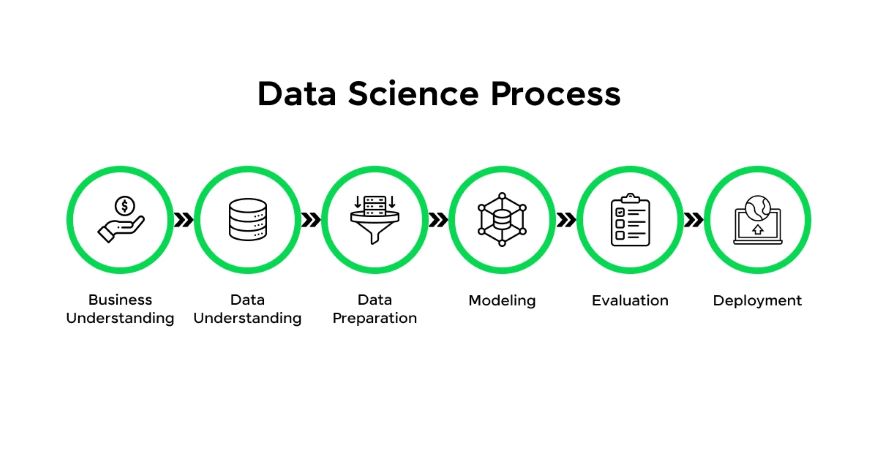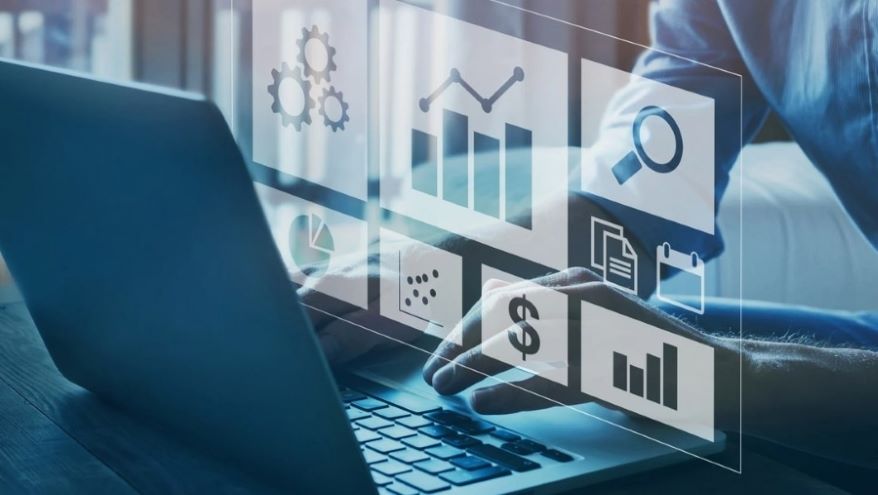Data shapes lives in countless ways. For instance, each time someone shops online, clicks on a suggested movie, or gets a weather update, data is at work behind the scenes. Moreover, businesses, health professionals, and city planners all use data to make better decisions. Both data science and big data are essential to this process, thereby helping individuals and organizations alike transform simple facts into actionable insights. Specifically, this Introduction to Data Science and Big Data Concepts highlights how the world of data offers many opportunities, enabling everyone to make smarter choices and improve society.
Data Science Basics

What Is Data Science
You use data science every day, even if you do not notice it. In fact, Introduction to Data Science and Big Data Concepts helps explain how data science helps you make sense of large amounts of data. Specifically, you can use it to find patterns, make predictions, and solve problems. Moreover, a data scientist uses math, computers, and data analysis to find answers. For example, you see data science in action when you get movie suggestions or weather updates.
Data science is not just about numbers. It helps you turn raw data into useful insights. You can use these insights to improve your life or help others.
Interdisciplinary Approach
Data science brings together many fields. Specifically, Introduction to Data Science and Big Data Concepts shows that you need math, computer science, statistics, and domain knowledge to understand and analyse data effectively. In other words, this means you must know about the area you study, like health or sports.
A data scientist works with teams. You may work with doctors, teachers, or business leaders. Each person brings a different skill. This teamwork helps you find better insights from the data Science.
Here is a table showing the main fields in data science:
| Field | What You Use It For |
|---|---|
| Math | Calculations, patterns |
| Computer Science | Handling large data |
| Statistics | Analysis and predictions |
| Domain Knowledge | Understanding the problem |
Data Science Process

You follow steps in the data science process. Each step helps you move from raw data to clear insights.
- Data gathering: You collect data from many sources.
- Cleaning: You fix errors and remove bad data.
- Analysis: You look for patterns and trends.
- Modeling: You build models to predict outcomes.
- Insights: You share what you learn with others.
You repeat these steps to get better results. You may need to go back and fix mistakes. This process helps you make sure your analysis is correct.
Data science and big data concepts give you tools to turn information into action. Moreover, you can use these tools in any field. As a result, you can help people, businesses, or even your city.
The 5 P’s
You can use the 5 P’s to guide your work in data science. These steps help you solve problems and find answers. Each “P” stands for a key part of the process. You will see how each step connects to the next.
| P | What You Do |
|---|---|
| Problem | Define the question |
| Plan | Decide how to solve it |
| Prepare | Collect and clean your data |
| Process | Analyze and model your data |
| Present | Share your results |
Problem
You start by asking a clear question. You need to know what you want to solve. A data scientist always begins with a goal. For example, you may want to predict sales or find patterns in health data.
Plan
Next, you make a plan. Then, you choose your tools and methods. After that, you decide how you will collect and use data. Ultimately, planning helps you stay organized.
Prepare
You gather your data. You clean it and fix mistakes. You make sure your data is ready for analysis. Good preparation saves time later.
Process
You use data science skills to study your data. You look for trends and build models. You test your ideas. This step helps you find answers.
Present
You share your findings. You use charts, graphs, or reports to show your results, explain them in simple words, and help others understand your work.
You can use the 5 P’s steps in school, business, or research, and you will see better results when you follow them. A data scientist uses this method to solve real-world problems.
Big Data Explained

What Is Big Data
You see big data everywhere. For example, every time you use your phone, you create data. Additionally, when you watch videos or send messages, you add more. In fact, data science and big data mean you work with huge amounts of data. Moreover, this data grows fast and comes from many sources.
You cannot use normal tools to handle big data. Therefore, you need special software and computers. In addition, introduction to data science and big data helps you find patterns in things like shopping, health, and weather. As a result, you can use it to make better choices.
The Three Vs
You can understand big data by learning about the Three Vs. These are Volume, Velocity, and Variety.
| V | What It Means |
|---|---|
| Volume | The amount of data you collect |
| Velocity | The speed at which data arrives |
| Variety | The different types of data |
- Volume: You deal with a lot of data. For example, social media creates billions of posts each day.
- Velocity: Data moves fast. You get new information every second.
- Variety: Data comes in many forms. You see text, pictures, videos, and more.
You need to manage all three to use big data well. If you miss one, you may lose important information.
Unstructured Data
Most big data is unstructured. This means it does not fit in neat tables. For example, you see unstructured data in emails, photos, and videos. As a result, it can be hard to organize and search.
You need smart tools to work with unstructured data. These tools help you find meaning in messy information. For example, you can use programs to read text or scan images.
Big data gives you a way to learn from all kinds of information. You can use it to solve problems and answer questions that were too hard before.
Big Data Challenges
Working with big data is challenging because you must manage large amounts of information, use powerful computers and smart software, and keep the data secure.
Here are some common challenges:
- Storage
You need space to keep all your data. Regular computers cannot store so much information. You use special servers or cloud systems. - Processing Speed
You want answers fast. Big data moves quickly. Slow computers cannot keep up. You need tools that process data in real time. - Quality
You must check your data. Bad data gives wrong results. You clean and fix your data before you use it. - Security
You protect your data from hackers. You use passwords and encryption. You follow rules to keep private information safe. - Cost
You spend money on storage and software. You also pay for skilled workers. Managing big data can be expensive.
Table: Common Big Data Challenges and Solutions
| Challenge | Solution |
|---|---|
| Storage | Use cloud systems |
| Speed | Use fast processors |
| Quality | Clean your data |
| Security | Encrypt your data |
| Cost | Plan your budget |
To succeed in big data projects, you must plan for challenges, choose the right tools and people, and keep learning new skills.
Data Science and Big Data
Differences
You see data science and big data in many places. Moreover, these fields help you solve problems. Specifically, they use data in different ways. Data science focuses on finding answers. For example, you use analytics and predictive models to study data and guess future trends.
Big data works with huge amounts of data. Therefore, you need powerful computers and special tools to store, process, and analyse information quickly. For instance, businesses use big data to track sales and customer habits.
| Feature | Data Science | Big Data |
|---|---|---|
| Main Goal | Find insights | Handle large data |
| Tools | Analytics, models | Storage, fast tools |
| Use in Business | Predictive models | Track trends |
Connections
You connect data science and big data by using big data to get information, data science to study it, building predictive models, and using analytics to find patterns.
Business teams use both fields. You use charts, graphs, or reports to show your results, explain them in simple words, and help others understand your work.
- You gather data from many sources.
- You use analytics to study the data.
- You build predictive models for business growth.
You get stronger results when you use both fields.
Working Together
Data science and big data work together daily by collecting information, turning it into action, and helping businesses make smart choices. Additionally, they use analytics to spot trends.
Consequently, business leaders use these tools to plan. Furthermore, you use predictive analysis to guess what customers want, analytics to improve sales, and help teams work faster and smarter.Here are the simplified sentences for your ideas:
- You use data to solve problems.
- You use analytics to find answers.
- You help business grow with smart tools.
You make better decisions when you use data science and big data together.
Data Analytics in Action

Data Analytics Overview
You use data analytics to make sense of information. It helps you turn raw data into useful insights. When you use analytics, you can spot trends and patterns. This process helps you answer questions and solve problems.
A data analyst collects and studies data. First, you use tools to clean and organize information. Then, you use analysis to find answers. Often, you use data visualization to show your results. Consequently, charts and graphs make your findings clear.
You see data analytics in many places. For example, sports teams use analytics to improve their game. Stores use data analysis to track sales. Doctors use analytics to study patient health.
Data Engineering
You need strong systems to handle lots of data. Specifically, data engineering builds these systems. In fact, you use it to collect, store, and move information. Additionally, a data analyst relies on these systems to get clean data.
You use pipelines to move data from one place to another. You clean and prepare the data before analysis. This step makes sure your analytics work well.
Here is a simple table showing what data engineering does:
| Task | Why It Matters |
|---|---|
| Collect | Gather all needed data |
| Store | Keep data safe |
| Clean | Fix errors in data |
| Prepare | Get data ready for use |
You need good data engineering for strong analytics. Without it, your insights may be wrong.
Machine Learning
You use machine learning to teach computers to learn from data. In fact, this part of data analytics helps you predict outcomes. For example, you feed the computer lots of data. Then, the computer finds patterns and makes predictions.
For example, you use machine learning to suggest movies or spot spam emails. You also use it in health care and business. Analytics gets smarter with more data.
You often use visualization to check how well your model works. You see results in charts or graphs. This helps you understand your insights.
Data analytics brings together many skills. For example, you use data engineering to build systems, machine learning to predict and improve, and data visualization to share your findings. Altogether, all these steps help you turn data into action.
Data Visualization
You see patterns in data when you use data visualization. In fact, this step helps you turn numbers into pictures. For example, you can use charts, graphs, and maps. These tools make information easy to understand. As a result, data visualization lets you spot trends quickly.
When you work with data analytics, you often use data visualization. For example, you can show results with a bar chart or a pie chart. These visuals help you explain your findings to others. In fact, people understand pictures faster than tables of numbers.
You can use different types of visualization. Each type works best for certain data. Here is a table to help you choose:
| Type of Visualization | Best Use Case |
|---|---|
| Bar Chart | Compare categories |
| Line Graph | Show changes over time |
| Pie Chart | Show parts of a whole |
| Map | Show data by location |
| Scatter Plot | Show relationships |
You use data visualization in many fields. For example, in health, you can track disease spread on a map. In business, you can show sales growth with a line graph. Similarly, in sports, you can compare player stats with a bar chart.
Data analytics becomes more powerful with good visualization. Consequently, you can share your insights with your team. Furthermore, you can help leaders make better choices. In addition, you can also spot mistakes or outliers in your data.
When you create a visualization, keep it simple. Too much detail can confuse people. Use clear titles and labels. Make sure your colors stand out.
- Use visualization to tell a story.
- Show only the most important data.
- Check your work for errors.
You can use free tools for data visualization. Try Google Charts, Tableau Public, or Microsoft Power BI. These tools help you create charts and graphs without coding.
Also Read https://nycstem.in/why-stem-discover-essential-skills-through-stem-learning-today/
Introduction to Data Science for Business

Business Impact
You see data science for business changing how companies work. In fact, you use data to make smart choices. Additionally, you can spot trends and find new markets. Moreover, analytics helps you understand what customers want. As a result, you use data-driven decision making to lower costs and boost profits.
Many companies use data analysis to improve products. For example, you can test ideas before spending money. Additionally, analytics shows what works and what does not. As a result, you get clear insights from your data. Ultimately, this helps you stay ahead of your competition.
You also use data science applications in business to track sales and manage risks. For example, you can see which ads work best. Additionally, you can plan for busy times. As a result, analytics gives you the power to act fast.
Industry Examples
You find data science applications in many fields. For instance, in healthcare, you use analytics to spot disease patterns. Hospitals use data to track patient care. Additionally, doctors get insights from test results. Ultimately, this helps save lives.
In marketing, you use analytics to study customer habits. For example, you can see which products sell best. Additionally, you use visualization to show sales trends. Consequently, marketers use data-driven decisions to plan ads.
Smart cities use data science applications to improve daily life. For example, you use data to control traffic lights. Moreover, city leaders use analytics to plan bus routes. Additionally, you can see how many people visit parks. Ultimately, these insights help cities run better.
In finance, you use data science to spot fraud. For example, banks use analytics to check credit scores. Additionally, you can see risky loans before they cause problems. Ultimately, data helps keep money safe.
| Industry | Application Example |
|---|---|
| Healthcare | Track patient health |
| Marketing | Study buying habits |
| Smart Cities | Manage traffic and services |
| Finance | Spot fraud and risks |
Avoiding Bias
You must use data fairly. Otherwise, bias can hurt your business. If you use bad data, your analysis may be wrong. Therefore, you need to check your data for errors. Additionally, you should use many sources.
A data analyst checks for bias in every step. To begin with, you use analytics to test your results. Then, you share your insights with your team. Additionally, you ask questions and look for mistakes.
You use clear visualization to show your findings. Additionally, you explain your choices. As a result, you help others see how you use data. Ultimately, this keeps your business honest and strong.
Skills and Tools required for data science
Technical Skills
You need strong technical skills to work in data science and big data. These skills help you solve problems and work with data. Specifically, you learn how to collect, clean, and study data. Additionally, you also learn how to use computers to process information.
A data scientist uses math and statistics every day. You use these skills to find patterns and make predictions. You also need to know how to use computers and software. These skills help you work faster and smarter.
Here are some important data science skills:
- Math and statistics
- Data cleaning
- Data analysis
- Computer skills
- Problem-solving
You build these skills over time. Each project helps you learn more.
Programming Languages
You use programming languages to talk to computers. These languages help you work with data and build models. Some languages are easy to learn. Others take more time.
The most popular languages for data science are Python and R. Python is simple and flexible. R is great for statistics and graphs. You may also use SQL to work with databases.
Here is a table of common programming languages and their uses:
| Language | Best For |
|---|---|
| Python | Data analysis, modeling |
| R | Statistics, graphs |
| SQL | Databases |
| Java | Big data tools |
You do not need to learn every language. Start with one. Practice often. You will get better with time.
Tools and Software
You use many data science tools to work with data. These tools help you collect, clean, and study information. Some tools are free. Others cost money.
Here are some popular data science tools:
- Jupyter Notebook: Lets you write and test code.
- Tableau: Helps you make charts and graphs.
- Excel: Good for simple data tasks.
- Power BI: Makes reports and dashboards.
- TensorFlow: Used for machine learning.
You pick the right tool for each job. Some tools work better for big data. Others are best for simple tasks.
You will use these tools every day as a data scientist. They help you turn data into answers. You also use them to share your findings with others.
Soft Skills
You need more than technical skills in data science. You also need strong soft skills. These skills help you work well with others. They help you share your ideas. You use them every day in your job.
Soft skills make you a better team member. Consequently, you solve problems faster. Additionally, you build trust with your team. Moreover, you also help your projects succeed.
Here are some key soft skills for data science:
Communication
You must explain your findings clearly. Therefore, use simple words. Also, avoid jargon. Moreover, share your results with people who may not know data science. Ultimately, good communication helps everyone understand your work.
Teamwork
You often work with others. For example, you join teams with people from different backgrounds. You listen to their ideas and share your own. Ultimately, teamwork helps you find better solutions.
Critical Thinking
You ask questions. Additionally, you check your data. Moreover, you do not accept results without proof. Overall, critical thinking helps you avoid mistakes.
Problem-Solving
You face new problems every day. Therefore, you look for answers. Next, you test different ideas. Moreover, you do not give up easily. Ultimately, problem-solving helps you reach your goals.
Adaptability
Data science changes fast. New tools appear often. Therefore, you must learn new things quickly. Ultimately, adaptability helps you stay ready for change.
Time Management
You work on many tasks at once. First, you set goals. Then, you plan your day. Overall, good time management helps you finish your work on time.
Table: Key Soft Skills and Why They Matter
| Soft Skill | Why It Matters |
|---|---|
| Communication | Share ideas and results clearly |
| Teamwork | Work well with others |
| Critical Thinking | Avoid errors and check your work |
| Problem-Solving | Find answers to tough questions |
| Adaptability | Learn new tools and methods quickly |
| Time Management | Meet deadlines and stay organized |
You use soft skills in every project. For example, you talk with your team. Additionally, you share your findings with leaders. It also help others understand your work. Therefore, these skills help you grow in your career
You can build your soft skills over time. For example, join group projects. Then, practice speaking in front of others. Additionally, ask for feedback. Each step helps you get better.
Future Trends in data science and big data

Emerging Tech
You will see new technology change data science every year. For example, artificial intelligence (AI) grows fast. In fact, AI helps you make better predictions from large data sets. Additionally, you can use AI to spot patterns that people miss. Quantum computing is another big step. It can solve problems much faster than normal computers. Moreover, you will also see more automation. For instance, machines can now clean and sort data for you. This saves time and reduces mistakes.
Here are some new trends you should watch:
- AI and machine learning for smarter predictions
- Quantum computers for faster data processing
- Automation tools for easier data cleaning
Ethics and Privacy
You must think about ethics when you use data. People trust you with their information. You need to keep it safe. Always follow privacy laws. Do not share private data without permission. You should also check your data for bias. Fair data leads to fair results.
Here is a table to help you remember key points:
| Issue | What You Should Do |
|---|---|
| Privacy | Protect personal data |
| Bias | Check for unfair patterns |
| Consent | Ask before using data |
Learning Paths
You can start learning data science today. For example, many free courses exist online. You can also join groups or clubs at school. Additionally, practice with real data sets. Start by trying simple projects first. As you learn, you will get better at making future predictions. Moreover, you can read books or watch videos. Some people join bootcamps for faster learning.
Here are steps to help you grow:
- Learn basic math and statistics.
- Practice coding with Python or R.
- Study data analysis and visualization.
- Work on small projects.
- Share your results with others.
You see data science and big data working together. These fields shape your world. You use them in business, health, and daily life. You find patterns and make smart choices.
References:
- Cao, L. (2017). Data Science. Association for Computing Machinery (ACM). https://doi.org/10.1145/3076253
- Cao, L. (2017). Data science. Association for Computing Machinery (ACM). https://doi.org/10.1145/3015456
- Deighton, J. (2018). Big data. In Consumption Markets & Culture (Vol. 22, Issue 1, pp. 68–73). Informa UK Limited. https://doi.org/10.1080/10253866.2017.1422902
- Memon, M. A., Soomro, S., Jumani, A. K., & Kartio, M. A. (2017). Big Data Analytics and Its Applications. In Annals of Emerging Technologies in Computing (Vol. 1, Issue 1, pp. 45–54). International Association for Educators and Researchers (IAER). https://doi.org/10.33166/aetic.2017.01.006
- Jeyaprakash, T., & K, P. (2021). Introduction to Data Science – An Overview. In International Journal of Science and Management Studies (IJSMS) (pp. 407–410). Science Research Publication. https://doi.org/10.51386/25815946/ijsms-v4i4p137